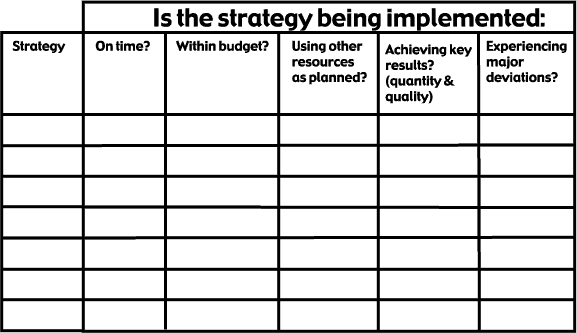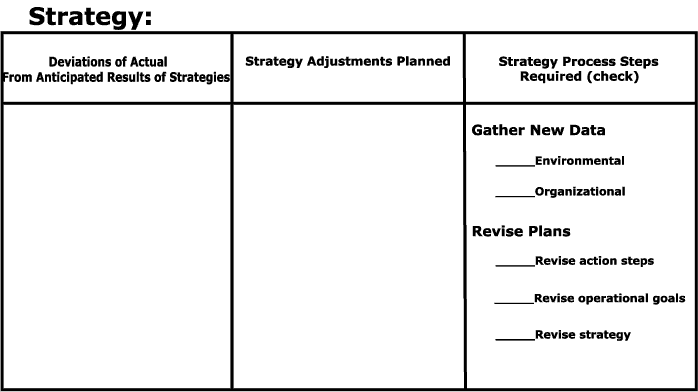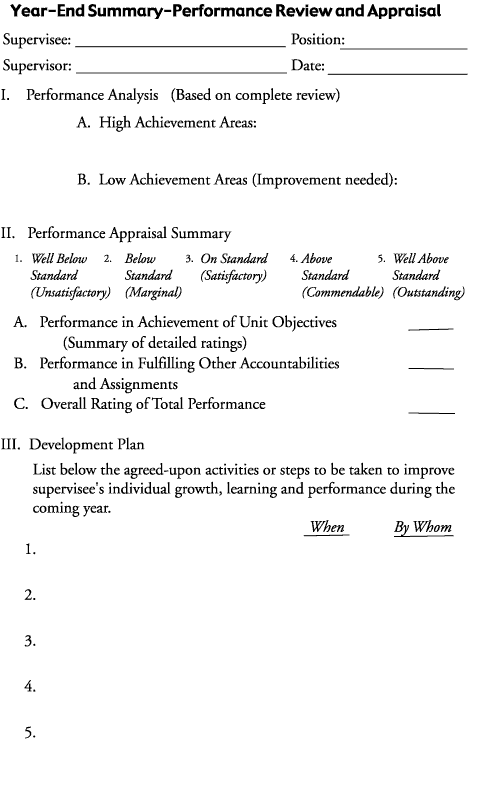OUTCOME ASSESSMENT Outcome assessment is the opportunity to measure how well you are doing and if you are having the impact you hoped for. Using the sailboat metaphor, this is where the captain keeps checking the course position and adjusting the sails and rudder as necessary. You begin this evaluation by comparing actual results of your strategies against targets (objectives and key results). Monitoring provides the opportunity to adjust strategies, resources, timing, or other factors, in order to get a plan that has gone off track back on track. Usually monitoring is continuous, with formal evaluation reports periodically reviewed by key staff. Major evaluation reports are generally developed on a semi-annual or annual basis. In the broad context, three kinds of questions are asked in this phase of Common Sense Management:
Strategic Plan Evaluation Outcome assessment as a step in the common sense management process involves these four activities: 1.Measure the results of strategy implementation. You may measure strategic performance at several levels. (1) You can monitor the performance of individual employees on action steps they are responsible for carrying out in support of institutional strategies. (2) You can also measure planned versus actual achievement on the objectives contained in your annual operational plan. (3) Finally, you can directly measure progress on institutional strategies. When you examine strategic performance, ask two questions: "How well are our strategies being implemented?" and "Are our strategies having the desired impact?" Assessment of individual performance and institutional performance on annual operational objectives provides information about how well institutional strategies are being implemented. Ask what has been accomplished to date on a given strategy, what results (quantitative and qualitative) have been seen to date, whether resources are being used as planned to carry out the strategy, and where you have fallen short in implementing the strategy to date. Figure 8-1 provides a simple worksheet for strategy implementation evaluation.
2.Analyze reasons for deviation of actual from anticipated results. If, in this measurement process, you determine that there is a deviation of actual from anticipated results, you must find the reasons for this deviation. Deviation may generally be ascribed to (1) resource performance different than anticipated, including staff performance and performance of technology, information, financial support, or facilities and equipment; (2) changes in the environment or the organization; and (3) a poorly designed strategy. Deviation from a plan may be positive or negative. That is, there may be overachievement as well as underachievement. Positive deviation may be ascribed to either (1) or (2) above, while negative deviation may be ascribed to any or all three reasons listed. Figure 8.2 provides a worksheet for this analysis.
3. Adjust or revise your strategic plan as required to achieve desired results. Once you determine the reason for deviation, adjust your plan if you want to get it back on track. Since deviation in strategy may be either positive or negative, this step involves either rescuing strategies that are not working or are not being properly implemented, or making adjustments that help your institution capitalize on strategy overachievement. If the strategy is underachieving, small adjustments are usually sufficient to get a strategy back on track. These adjustments usually involve changing the time frames for accomplishment or downscaling the quantity or quality of the planned product. In most instances, you will not have to abandon the entire strategy. If the strategy is overachieving, that is, if it is ahead of its target achievements, you may want to adopt a more ambitious new objective for the same timetable. Or you may chose to revise your timetable to accomplish the original objective in a shorter period. Figure 8.3 provides a worksheet for this evaluation.
4. Report results of performance evaluation. You should conduct an annual evaluation of your strategic plan to identify reasons for implementation shortfalls (or overachievements) and to make proposals for adjusting the strategic plan or for altering specific strategies. Ask the committee charged with the review responsibility to examine the results of the annual performance evaluation and report their finding to the board and staff for further action. Individual Performance Review The success or failure of strategy implementation is largely a factor of how well each individual within the institution does his or her job. Thus it is important to assess how well individuals carry out action steps and meet expected key results and strategy objectives. You must recognize and reward those who have performed well. When you assign individuals responsibility for specific strategies, objectives, and action steps, include built-in incentives geared to both strategic and short-term accomplishments. These incentives should be consistent with institutional aims and culture. They must be uniform and equitable, based on individual, group, or institutional performance. The incentives could include financial compensation or other perquisites within the institution's culture (e.g., special training opportunities, conference attendance, a larger office, title, association membership). In designing a system of rewards, then, senior leaders must examine how they design jobs, how much real responsibility and recognition employees derive from these jobs, and how individuals view their own growth. Notify individuals who do not perform of their deficiencies and work with them to develop a plan for improvement. Repeated poor performance should result in demotion or dismissal. Nothing kills a performance review system and employee morale than maintaining employees who do not perform. Figure 8.4 provides a simple worksheet for performance review.
Plan/Strategy Revision The evaluation of the implementation plan can alter strategies and objectives. Strategic plan, goals, strategies and objectives can also be altered due to changes in either the external environment or internal organization or both. Common sense management is a continuous process. So as things change, revise the strategic plan and its components as necessary. Expect under normal circumstances to alter your plan at least 10%. If you are in a volatile external environment you may face up to a 50% change or more. For example, if your institution is in a small to medium sized community and your students come from mainly that community you could find yourself in a volatile environment if the community's major industry suddenly goes out of business or moves away. The resulting unemployment and loss of related jobs could seriously hurt enrollment and fund raising. Suddenly what had previously seen as a fairly rosy environment has turned cloudy. Your strategic plan may well have to be seriously revised. At the end of outcomes assessment, you once again look outside and inside and ask the question "What's changed?" If nothing has changed, then the only changes necessary will be those indicated by the evaluation of what you have or have not accomplished. However, if significant changes have occurred, you must explore the implications of that change, determine the effect on current strategies, determine if new issues have arisen and institute the common sense process for those issues and consequential new strategies. The Product From Step Five The product of a successful outcome assessment is first an ongoing awareness, at all levels of the institution, of how well you are doing to plan for the future, and second, there should be an organizational readiness and ability to alter the plan to adapt to changing circumstances if necessary. Critical to an effective process is the continuous monitoring of the external environment and assessment of your institution's internal capacities. These enable you to adjust your strategies and/or to begin a new cycle of strategic management.
|



